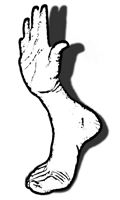Quince Missing Notes

Q is an exploration of urban isolation. It captures a random moment in dance. It is nite. In the streets. At this moment one man struggles to take another step forward. Two strangers try to pass by each other, and a trio is locked in anonymous antagonism. These six men pass closely, maybe even repeatedly, and yet never have a chance to find friendship with each other.
The movement was developed though experimentation with internalizing the fear of strangers passing on the street. In the rehearsal process we imagined someone unknown to us passing by, in the nite, in an unfamiliar part of the city. What does he want? How can I protect myself from him? These unfounded fears spur small tension in our bodies. We tracked the tension and developed choreography out of both the subtlety of these tensions and the expansions of it to grotesque forms.
In the shooting of the work we continued the experimentation with scores developed in rehearsal. These explorations are colored by dancers grounded in disparate dance disciplines. I am very interested in playing with the line between what looks like very pedestrian movement and yet is actually highly choreographed. Even though my interest is in going beyond traditional forms, each dancer has dedicated himself to a primary training: Post-Modern Dance, Tango, Butoh, or Contact Improvisation. In the project footage on the DVD you may recognize some elements of these forms.
IÃm trying to bring a typical choreographic process to the art of making cinema. The movement is based on an idea. The structure of the piece will be based on the movement that was generated out of the idea. The choreography will be structured largely in the process of editing the films. I like to let the work take shape organically without presupposing too much from the outset.
Q is the third film of a series of dance film portraits. IÃm trying to find an exquisite little conjunction of choreographic, cinematic and poetic practice that illuminates something unique in this hybrid medium. This idea of a moving portrait allows me to go beyond the usual narrative conventions of cinema and the usual abstract conventions of post-modern dance. IÃm trying to get at an essential expression, something unmediated by spoken or written language.

